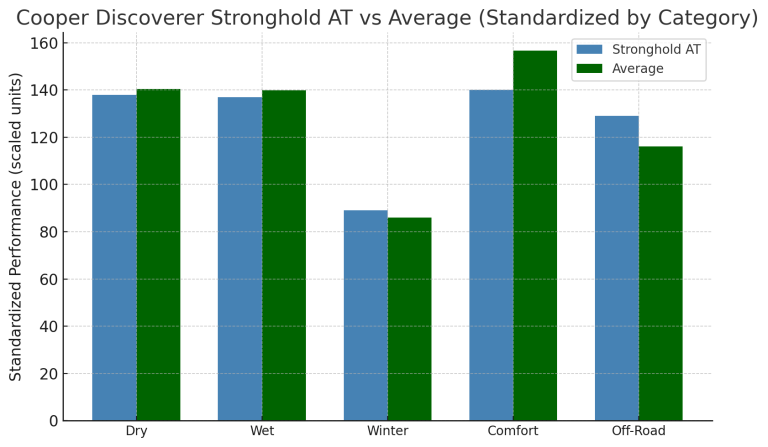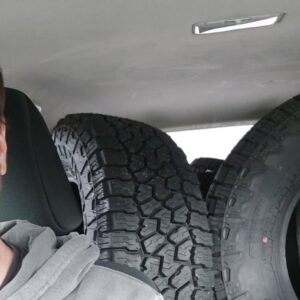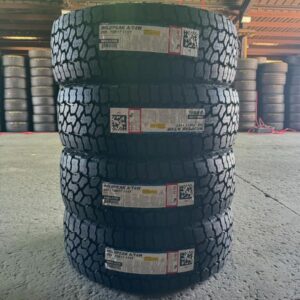Cooper Discoverer Road + Trail is the first tire in Cooper’s A/T lineup transition. It is meant to replace the Cooper Discoverer AT3 4S and, just like that tire, it is offered only in P-metric sizes. That immediately tells us what Cooper is prioritizing: on-road performance and comfort rather than ruggedness. The rugged side of the lineup is now handled by the Cooper Discoverer Stronghold AT, which I cover in a separate article.
In this review, I will break down the performance, design changes, and the direct evolution from the AT3 4S. Off-road enthusiasts and HD truck owners will be better served by the Stronghold AT review. For everyone else who wants a slightly more aggressive successor to the Cooper Discoverer AT3 4S, let’s move on.
In this article, you will find performance insights supported by test data, real driver feedback, and region-based usage recommendations.
Quick Look
Cooper Discoverer Road + Trail AT
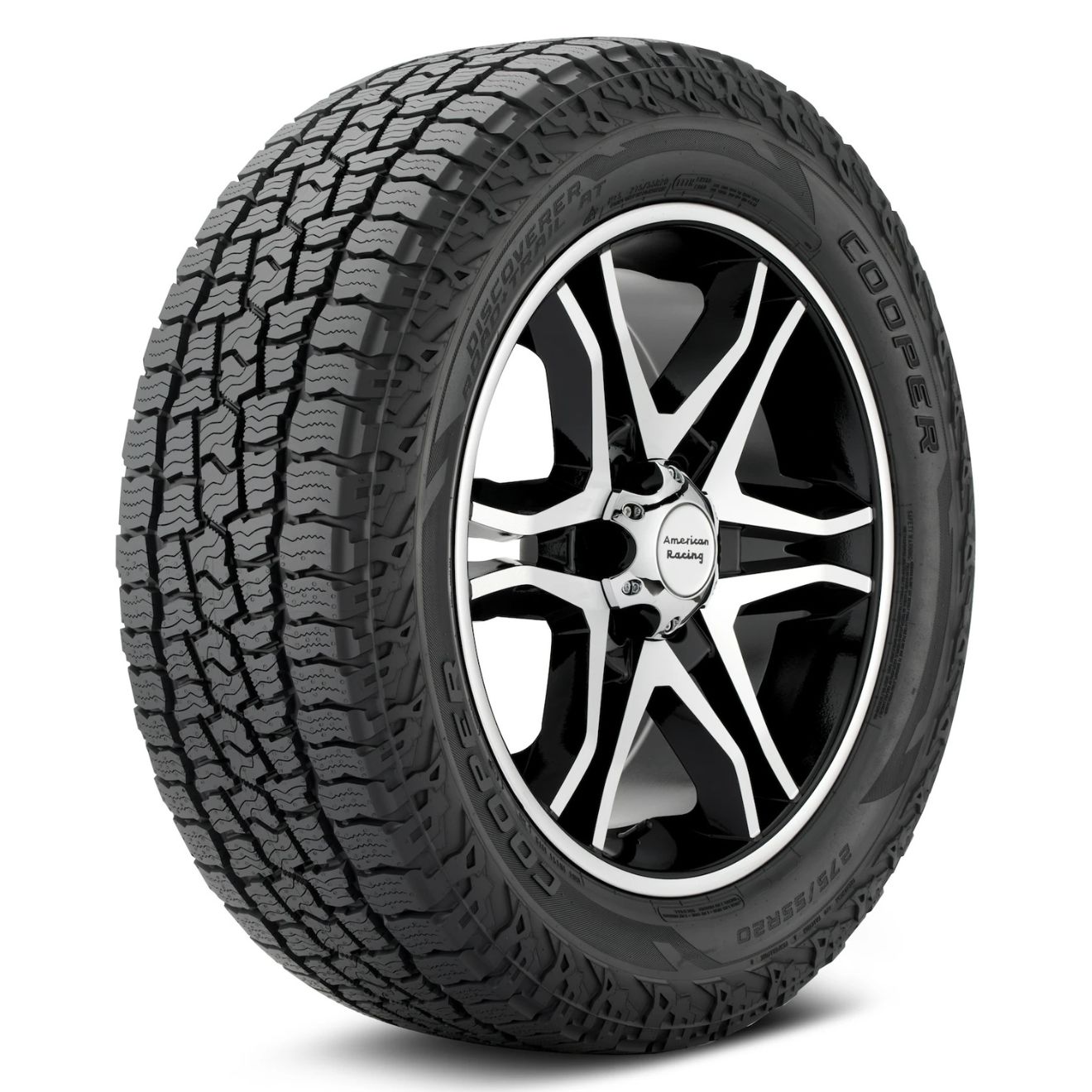
Retailers with the Best Prices I Found
As a former Bridgestone engineer, I can say the Cooper Discoverer Road + Trail AT is strong on dry handling, wet grip, and on-road comfort, offering responsive steering, stable lateral grip, and smooth, quiet rides. It performs very well in wet braking and hydroplaning resistance, and handles moderate snow adequately. Tread wears evenly with proper rotation, and the construction feels robust for an on-road A/T. Downsides? It’s not optimized for harsh winter conditions, and cornering on deep snow can be tricky; it also won’t rival true off-road tires in rugged terrain. Overall, this tire balances performance, comfort, and durability for drivers focused on pavement while keeping light off-road capability in the mix.
Dry Performance
Dry Performance Test Results
| Tire | Dry Overall | Dry Braking | Dry Cornering | Dry Handling | Dry Steering | Dry g-Force | Lap Time (sec) | Stopping Dist. (ft) |
|---|---|---|---|---|---|---|---|---|
| BFGoodrich All-Terrain T/A KO3 | 5.25 | 5.50 | 5.50 | 5.50 | 5.50 | 0.69 | 40.65 | 141 |
| Bridgestone Dueler A/T Ascent | 6.00 | 6.75 | 6.00 | 6.75 | 7.00 | 0.71 | 38.20 | 137 |
| Cooper Discoverer Road+Trail AT | 6.00 | 6.50 | 6.00 | 6.50 | 6.75 | 0.74 | 37.28 | 134 |
| Cooper Discoverer Rugged Trek | 6.00 | 6.38 | 6.00 | 6.38 | 6.75 | 0.72 | 39.51 | 137 |
| Cooper Discoverer Stronghold AT | 5.50 | 6.00 | 5.50 | 6.00 | 6.75 | 0.70 | 39.81 | 139 |
| Falken WildPeak A/T4W | 6.00 | 6.50 | 6.00 | 6.50 | 6.75 | 0.72 | 37.73 | 132 |
| Goodyear Wrangler DuraTrac RT | 5.50 | 5.75 | 5.50 | 5.75 | 6.75 | 0.71 | 41.17 | 141 |
| Hankook Dynapro AT2 Xtreme | 5.50 | 5.75 | 5.50 | 5.75 | 6.75 | 0.72 | 40.35 | 134 |
| Nitto Recon Grappler A/T | 5.25 | 6.00 | 5.50 | 6.00 | 6.75 | 0.70 | 41.22 | 140 |
| Nitto Terra Grappler G3 | 6.00 | 6.50 | 6.00 | 6.50 | 6.75 | 0.74 | 36.35 | 126 |
| Vredestein Pinza AT | 6.25 | 6.50 | 6.25 | 6.50 | 7.50 | 0.72 | 37.89 | 133 |
| Yokohama Geolandar A/T4 | 5.00 | 5.50 | 5.00 | 5.50 | 6.50 | 0.70 | 40.45 | 141 |
The Cooper Discoverer Road + Trail AT actually sits near the top of our dry test performance chart. It delivers confident dry handling and ranks inside the top four in dry braking with a 134 foot result. In my opinion, the real game changer in this category is not braking but g force and lap time, because most all terrain tires can stop well on dry pavement but usually fall short on steering response.
Cooper’s Road + Trail AT is an on-road focused all-terrain tire, and that is exactly why it out performs most competitors in this portion of the test. It only trails tires like the Nitto Terra Grappler G3 and the Vredestein Pinza AT. The reason is simple. While braking is heavily influenced by tread width, responsiveness is shaped by the design of the center section. The Road + Trail uses a continuous rib style center section that improves steering precision. However, its tread is slightly wider than the Terra Grappler G3, which is why it falls just behind it in lap time. When it comes to g-force, which reflects aggressive and immediate responsiveness, the two are tied because the Terra Grappler G3 in this test was an XL load tire. XL-rated tires have stiffer sidewalls, which helps lateral grip.
Real driver feedback supports this on-road focused character:
“The tires were quiet, with excellent dry and wet grip.”
“The Cooper Discoverer is great in heavy rain and provides excellent dry traction.”
“Balanced out nicely and the ride and handling are top tier!”
“The tires ride and look nice, are quiet on the road, and show no sign of wear.”
Overall, the Cooper Discoverer Road + Trail AT is one of the strongest options in the category for dry performance, especially for daily driven P metric crossovers, SUVs, and half tons.
Wet Performance
Wet Performance Test Results
| Tire | Wet Overall | Wet Braking | Wet Cornering | Wet Handling | Wet Steering | Wet g-Force | Lap Time (sec) | Stopping Dist. (ft) | Slalom Time (sec) |
|---|---|---|---|---|---|---|---|---|---|
| BFGoodrich All-Terrain T/A KO3 | 4.75 | 5.00 | 4.75 | 5.00 | 5.50 | 0.51 | 40.65 | 184 | 8.02 |
| Bridgestone Dueler A/T Ascent | 6.75 | 7.00 | 6.50 | 6.75 | 7.50 | 0.58 | 38.20 | 167 | 7.31 |
| Cooper Discoverer Road+Trail AT | 6.50 | 7.00 | 6.50 | 6.75 | 7.00 | 0.59 | 37.28 | 172 | 7.10 |
| Cooper Discoverer Rugged Trek | 6.00 | 6.00 | 5.75 | 6.00 | 6.75 | 0.53 | 39.51 | 180 | 7.63 |
| Cooper Discoverer Stronghold AT | 5.25 | 5.50 | 5.50 | 5.75 | 6.75 | 0.53 | 39.81 | 180 | 7.81 |
| Falken WildPeak A/T4W | 6.25 | 6.50 | 6.25 | 6.50 | 7.00 | 0.57 | 37.73 | 171 | 7.31 |
| Goodyear Wrangler DuraTrac RT | 5.25 | 5.00 | 5.25 | 5.25 | 6.75 | 0.50 | 41.17 | 192 | 7.97 |
| Hankook Dynapro AT2 Xtreme | 4.75 | 5.50 | 5.00 | 5.00 | 6.50 | 0.53 | 40.35 | 172 | 7.81 |
| Nitto Recon Grappler A/T | 5.00 | 5.75 | 5.25 | 5.25 | 6.50 | 0.48 | 41.22 | 192 | 8.00 |
| Nitto Terra Grappler G3 | 6.75 | 7.00 | 6.75 | 6.75 | 7.25 | 0.61 | 36.35 | 158 | 7.31 |
| Vredestein Pinza AT | 7.00 | 7.25 | 7.00 | 7.00 | 7.50 | 0.58 | 37.89 | 170 | 7.26 |
| Yokohama Geolandar A/T4 | 4.75 | 5.00 | 4.75 | 5.00 | 6.50 | 0.52 | 40.45 | 177 | 8.00 |
Wet performance in all terrain tires is always more complex than dry performance because hydroplaning resistance becomes a major factor. Let’s walk through the test results and what they mean on the road.
First of all, wet stopping distance still matters, but it is only relevant when the surface is wet without any standing water. In this scenario the Cooper Discoverer Road + Trail AT performs very well with a 172 foot wet braking distance. It is not the best in the category, but it still ranks inside the top five.
Where this tire actually stands out is wet lateral grip, which is why it takes second place with a 0.59 g force rating and even leads the wet slalom time. So, is the tire agile on wet pavement? Yes, absolutely. Steering response stays predictable and body movement stays controlled.
When it comes to hydroplaning, this is where the Road + Trail AT really separates itself. Even though hydroplaning resistance also depends on driving speed and driver input, the tire performs very well in objective hydroplaning tests and subjective evaluations. Hydroplaning becomes critical in harsher conditions where standing water builds up on the road. In those scenarios, the tire’s ability to evacuate water quickly makes all the difference.
The Road + Trail AT uses a highway inspired rib structure that carries water out through the shoulder channels efficiently. Water evacuation is genuinely strong here. It does not perform at the same level as highway all season tires that score in the S plus range, but it easily qualifies as an S tier wet performer within the all terrain segment.
Wide lateral notches and circumferential grooves also help in wet conditions. While the lateral notches on the shoulders are not full depth, the tire compensates with a slightly softer compound compared to most all terrain competitors. Cooper intentionally chose this compound to improve wet traction without sacrificing fuel efficiency and tread life.
Real user feedback for wet performance:
“With the old tires in the rain any little extra bump of throttle off the line would give you a little spin. These are harder to break loose and feel confident in corners.” (BobIsTheOilGuy forum)
“Really confidence inspiring wet grip. Braking is especially impressive, even in standing water.” (Reddit r/TyreReviews)
“In Northern Michigan the Road + Trails were way better than the Falken AT3 in the rain. Honestly some of the best wet tires I’ve ever owned, which is wild for an AT tire.” (Reddit r/TyreReviews)
Overall, the Cooper Discoverer Road + Trail AT is a top tier wet performer among on road focused all terrain tires. It offers strong wet braking, excellent lateral grip, and very stable hydroplaning resistance, making it a confident choice for daily driven SUVs, crossovers, and half ton trucks in rainy climates.
Note from the Expert: When it comes to rain, I always emphasize two things: compound grip and water evacuation. You can see the full details in my analysis, but if you take just one thing away, remember that an AT tire’s stiff nature makes achieving top-tier wet performance a constant battle. This is why the question, Are All-Terrain Tires Good in Rain?, requires a nuanced answer that balances tread design against rubber stiffness.
Snow & Ice Performance
Snow & Ice Performance Test Results
| Tire | Snow Lap Time (sec) | Snow Accel Dist (ft) | Ice Accel Time (sec) | Snow Braking Dist (ft) | Ice Braking Dist (ft) | Snow Overall | Snow Accel | Snow Cornering | Snow Handling |
|---|---|---|---|---|---|---|---|---|---|
| BFGoodrich All-Terrain T/A KO3 | 28.25 | 46.41 | 6.23 | 72.34 | 53.30 | 4.50 | 4.50 | 5.50 | 5.50 |
| Bridgestone Dueler A/T Ascent | 26.25 | 36.69 | 5.48 | 67.85 | 41.20 | 5.50 | 5.50 | 5.50 | 5.50 |
| Cooper Discoverer Road+Trail AT | 27.69 | 42.47 | 5.79 | 71.54 | 44.40 | 4.75 | 4.75 | 5.00 | 5.00 |
| Cooper Discoverer Rugged Trek | 27.05 | 45.04 | 6.00 | 79.07 | 50.50 | 4.75 | 4.75 | 5.00 | 5.00 |
| Cooper Discoverer Stronghold AT | 26.90 | 47.37 | 5.75 | 72.50 | 52.30 | 5.67 | 5.00 | 5.50 | 6.00 |
| Falken WildPeak A/T4W | 27.45 | 49.06 | 5.96 | 82.28 | 47.50 | 5.50 | 5.50 | 5.50 | 5.50 |
| Goodyear Wrangler DuraTrac RT | 27.97 | 42.32 | 5.52 | 70.41 | 45.20 | 4.50 | 4.50 | 5.00 | 5.00 |
| Hankook Dynapro AT2 Xtreme | 27.68 | 41.67 | 5.39 | 76.78 | 41.20 | 4.50 | 4.50 | 5.00 | 5.00 |
| Nitto Recon Grappler A/T | 27.64 | 45.51 | 5.94 | 76.62 | 46.50 | 4.00 | 4.00 | 5.00 | 5.50 |
| Nitto Terra Grappler G3 | 29.93 | 45.16 | 6.06 | 86.87 | 47.80 | 3.50 | 3.50 | 5.00 | 5.00 |
| Vredestein Pinza AT | 27.94 | 40.53 | 6.61 | 76.77 | 47.40 | 5.50 | 5.50 | 5.50 | 6.00 |
| Yokohama Geolandar A/T4 | 27.16 | 47.79 | 6.04 | 71.85 | 48.50 | 3.50 | 3.50 | 5.00 | 5.50 |
Snow and ice performance is really subjective for on‑road all‑terrain tires. That is why Cooper Discoverer Road + Trail AT shows different performance in testing.
First of all, Road + Trail AT is an on‑road oriented tire. For this reason, its grip at start-up in snow is not as strong as more aggressive tires such as the Falken Wildpeak AT4W or Cooper Discoverer Stronghold AT. It needs more distance to accelerate, but it still finishes in the top three for snow stopping distance with 71.54 ft, and stops on ice in 44.40 ft — both solid results.
However, on snow corners the story shifts. The narrower tread pattern reduces handling capability, so cornering on snow can be more difficult for a tire like this. That is why I recommend a more rugged all-terrain tire rather than an on-road A/T for regions that see snow frequently.
Real user feedback:
“Really impressive snow traction. I tested in deep snow and a variety of slushy conditions. The RAV4 had no trouble at all going through 4‑6 inches of snow … even starting up a hill … provided no trouble at all.” — r/TyreReviews (reddit.com)
“I’ve had them on for about 30 k miles. Really like them, quiet and decent traction in the snow.” — r/gmcsierra (reddit.com)
“I bought these last year and they were great in snow.” — r/NissanFrontier (reddit.com)
“No spinning at all. Makes it up my hill in 2wd without any issues … Only con so far is cornering in the snow. They like to slide sideways. But it’s not an uncontrollable slide.” — TacomaWorld forum (tacomaworld.com)
Overall, the Cooper Discoverer Road + Trail AT is one of the most optimized options for on-road A/T drivers who face light to moderate snow. It’s not built for the worst winter conditions, but it will likely give you everything you need in more temperate, snowy climates.
Note from the Expert: Our discussions often boil down to the core tradeoff. On one hand, you must understand why all-terrain tires are truly effective in deep snow, but not on ice. On the other hand, you face the 3PMSF Paradox—the hidden cost of that badge. The short answer is: The 3PMSF badge certifies traction, but it costs you durability. Dive into our full analysis on the critical 3PMSF rating for severe winter and off-road service, and its hidden costs, before you risk your rig on the trail.
Noise & Riding Quality
On-Road Test Performance
| Tire | Overall Road Rating | Noise | Ride Quality | Steering & Handling |
|---|---|---|---|---|
| BFGoodrich All-Terrain T/A KO3 | 5.50 | 5.75 | 6.00 | 7.50 |
| Bridgestone Dueler A/T Ascent | 6.50 | 6.75 | 6.50 | 7.00 |
| Cooper Discoverer Road+Trail AT | 6.75 | 7.00 | 7.00 | 7.25 |
| Cooper Discoverer Rugged Trek | 6.00 | 6.50 | 6.50 | 6.75 |
| Cooper Discoverer Stronghold AT | 5.25 | 5.50 | 6.00 | 7.25 |
| Falken WildPeak A/T4W | 6.50 | 6.50 | 6.50 | 6.75 |
| Goodyear Wrangler DuraTrac RT | 6.00 | 6.00 | 6.50 | 6.50 |
| Hankook Dynapro AT2 Xtreme | 5.75 | 6.00 | 6.50 | 7.00 |
| Nitto Recon Grappler A/T | 6.25 | 6.00 | 6.25 | 7.25 |
| Nitto Terra Grappler G3 | 6.00 | 6.00 | 5.50 | 6.50 |
| Vredestein Pinza AT | 7.00 | 7.50 | 7.50 | 7.50 |
| Yokohama Geolandar A/T4 | 5.75 | 6.00 | 6.50 | 6.50 |
This section is, in my point of view, where Cooper Discoverer Road + Trail AT really shines for an aggressive on-road A/T tire. Tires like Vredestein Pinza AT, with a less aggressive design, of course dominate this section. However, what surprised me is that the Road + Trail AT performs better than Bridgestone Dueler Ascent.
In this case, the narrower tread pattern actually pays off, especially in steering precision. The five-rib design is great for sequencing the shoulders with the center section and reducing noise, while also providing better riding quality due to its compact layout.
Besides that, the tire has a strong sidewall with a center section featuring step-down elements (which act like a spring to absorb bumps). This makes it a comfortable and quiet tire overall.
Real user feedback:
“These tires are surprisingly quiet for an AT. On the highway at 70‑75 mph, there’s minimal drone, and bumps feel well-absorbed.” — r/TyreReviews (reddit.com)
“I swapped from Dueler Ascent and honestly these feel smoother. Cornering noise is lower, and it feels more stable over uneven roads.” — r/gmcsierra (reddit.com)
“Very happy with the ride. Handles small bumps and expansion joints better than expected, and the cabin stays quiet even on coarse pavement.” — r/NissanFrontier (reddit.com)
Overall, the Cooper Discoverer Road + Trail AT is an impressive balance of comfort, low noise, and handling for an aggressive on-road all-terrain tire. It’s quieter and smoother than many competitors, making it ideal for daily-driven SUVs, crossovers, and half-ton trucks.
Note from the Expert: For years, choosing all-terrain meant accepting noise—a true compromise for off-road grip. That’s why the question, Are All-Terrain Tires Louder than Highway Tires?, used to have a simple “yes” answer. Now, with the rise of on-road models, the core issue has shifted from noise to overall refinement. To fully understand which side of the comfort spectrum you’re buying into, you need to determine Are All-Terrain Tires Good for Daily Driving?—a question that depends entirely on the tire’s construction, not just the name.
Treadwear & Durability
Cooper Discoverer Road + Trail AT is actually slightly behind top competitors like Vredestein Pinza AT and Nitto Terra Grappler G3 in terms of tread wear and durability. It offers a 65,000‑mile warranty, while Vredestein and Nitto provide 70k+ and more highway-oriented options like Michelin Defender LTX MS2 offer 75k.
The Road + Trail AT has a slightly more aggressive design than the Vredestein, which is expected. Nitto, on the other hand, puts more rubber on the ground and has slightly higher tread depth.
With a 620 A B UTQG rating, Cooper Road + Trail places itself between those two options. The strong two-ply construction helps the tire keep its shape and wear evenly. Of course, with this kind of design, proper rotation always helps prolong life and even wear.
On the other hand, this tire isn’t a true off-roader. If you put it through harsh conditions, it will probably hold up, but tread wear will increase dramatically.
Real user feedback:
“I’ve had them on for about 30k miles. Really like them, quiet, and they seem to wear evenly so far. Rotation helps too.” — r/gmcsierra (reddit.com)
“Just put 7k miles on my Road + Trail ATs … still no uneven wear. Tires are holding up well for daily highway + some light snow driving.” — BobIsTheOilGuy (bobistheoilguy.com)
“Rotation definitely helps. I rotate every 5k and the tires are still even after 15k miles. Haven’t noticed any cupping or feathering.” — r/KiaTelluride (reddit.com)
Overall, the Cooper Discoverer Road + Trail AT can last about 70‑80k miles, depending on your driving style and maintenance habits. It offers a solid balance of tread life and durability for an on-road focused all-terrain tire.
Cooper Discoverer Road + Trail AT is designed for on-road focus but handles light trails, dirt, and mild mud better than most on-road all-terrain tires. Its highway-inspired center rib and P-metric sizing give it stable handling and predictable traction on gravel roads, packed dirt, and forest trails, making it a solid choice for weekend adventures or secondary off-road use.
Users agree that it excels where other on-road AT tires struggle:
“They are fantastic! No change in road noise or ride quality and are fantastic off pavement.” — r/LandRoverDiscovery (reddit.com)
“Quiet on gravel, and I really can’t rave about them enough.” — r/GrandCherokee (reddit.com)
For muddy patches or loose dirt, it performs respectably, though the narrower tread and less aggressive shoulders mean it won’t match the grip of dedicated off-road tires like the Cooper Stronghold AT or Falken Wildpeak AT4W. A Bronco Sport forum user noted:
“Very happy with the look, the ride, and the off-road capabilities. These did great in the outback of Wyoming and are nice and quiet on the highway.” (broncosportforum.com)
Some owners still emphasize its limitations in severe off-road conditions:
“Handling seems good on trails and dirt roads, but I haven’t driven them in extreme terrain or deep mud yet.” (4runners.com)
Bottom line: The Road + Trail AT is ideal for light trails, dirt roads, and mild mud, outperforming most on-road all-terrain tires in these conditions. Severe off-road use, including deep mud, sand, and rock crawling, remains beyond its design intent. However, it balances off-road capability with highway comfort and quiet ride better than almost any P-metric on-road AT tire.
Note from the Expert: Every successful day on the trail is about preparation and physics, because tire longevity is earned, not given. Before you even start, you must master the critical link between tire pressure and load range for every rig to maximize your contact patch. Once moving, remember your ultimate off-road armor is your sidewall protection against the inevitable pinch flat. And finally, your traction on the obstacle is dictated by choosing the right aggressive vs hybrid tread pattern for your terrain. Master those three steps, and your rig will be ready for anything.
Conclusion & Region-Based Advice
The Cooper Discoverer Road + Trail AT is a well-rounded, on-road-focused all-terrain tire. It excels in dry handling, wet grip, noise and ride comfort, and even performs respectably on snow and light trails. Its treadwear and durability are solid for a P-metric A/T, offering predictable even wear with proper rotation, though it won’t outlast the most highway-oriented competitors.
Region-Based Recommendations:
Urban & Highway-Focused Drivers: Perfect for SUVs, crossovers, and half-ton trucks that spend most of their time on paved roads. You’ll get quiet rides, responsive handling, and long-lasting tread.
Rainy or Wet Regions: Strong lateral grip and hydroplaning resistance make it confident in wet conditions. Ideal for regions with frequent rain or occasional standing water.
Light Snow / Mild Winter Areas: Adequate for moderate snow, but in regions with harsh winters or deep snow, a dedicated winter tire or more aggressive A/T (like Cooper Stronghold AT) is recommended.
Light Trail / Dirt Roads: Handles gravel, dirt, and mild mud better than most on-road A/T tires. Outperforms many competitors in this category, but avoid severe off-road conditions like deep mud, sand, or rocks.
Hot & Dry Climates: Performs well on paved roads in hot weather, maintaining stable handling and tread life, thanks to its highway-inspired design and robust construction.
Overall: The Cooper Discoverer Road + Trail AT is a balanced, versatile tire for drivers who prioritize on-road performance but still want light off-road capability. It’s a smart choice for daily driving, occasional light trails, and regions with moderate wet or winter conditions — delivering confidence, comfort, and durability without overcommitting to extreme off-road use.
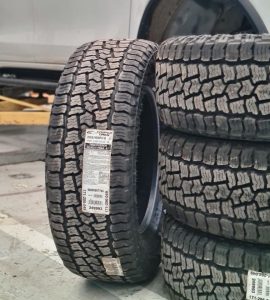
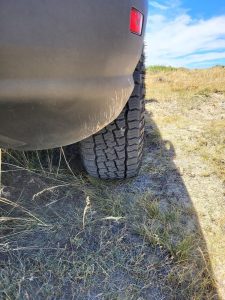




 Verdict: With a 60k treadwear warranty, durable construction, and competitive pricing, the Stronghold AT hits a sweet spot for drivers who want real off-road performance backed by Cooper’s protection. It may not be the cheapest A/T, but the mix of durability and warranty coverage gives it strong value for money.
Verdict: With a 60k treadwear warranty, durable construction, and competitive pricing, the Stronghold AT hits a sweet spot for drivers who want real off-road performance backed by Cooper’s protection. It may not be the cheapest A/T, but the mix of durability and warranty coverage gives it strong value for money.